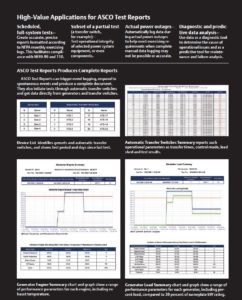It is a requirement that backup generators in Hospitals must have emergency power testing programs in place to meet the requirements of NFPA 70, NFPA 99 and NFPA 110, as well as standards established by accreditation organizations such as JCAHO. Dream Report is an excellent solution for the automated documenting this very important process.
 Certification requirements NFPA 101 requires that emergency generators be installed, tested and maintained in accordance with NFPA 110, Standard for Emergency and Standby Power Systems. Buildings that fall under NFPA 101 and are equipped with or in which patients require the use of life-support systems (e.g. hospitals, nursing homes with residents on ventilators) must also meet the maintenance and testing provisions of NFPA 99, Standard for Health Care Facilities. Provisions dealing with maintenance and testing of emergency generators can be found in NFPA 99.
Certification requirements NFPA 101 requires that emergency generators be installed, tested and maintained in accordance with NFPA 110, Standard for Emergency and Standby Power Systems. Buildings that fall under NFPA 101 and are equipped with or in which patients require the use of life-support systems (e.g. hospitals, nursing homes with residents on ventilators) must also meet the maintenance and testing provisions of NFPA 99, Standard for Health Care Facilities. Provisions dealing with maintenance and testing of emergency generators can be found in NFPA 99.
- Testing intervals
- Test conditions
- Personnel qualifications
- Maintenance and testing of circuitry
- Maintenance of batteries
Monthly testing
To meet federal certification and state licensure requirements, healthcare facilities must exercise their emergency generators under load at least monthly [see NFPA 110]. There are a number of ways to comply with this requirement:
The base requirement is that generators be exercised for a minimum of 30 minutes* using one of the following methods [see NFPA 110].
Under operating temperature conditions and at not less than 30 percent of the generator’s nameplate kW rating. A 100 kW generator, for example, would need to be exercised under a load of at least 30 kW to meet this requirement.
Normal operating temperatures are set by the manufacturer. Something to consider when scheduling your monthly tests is that your particular generator may not reach operating temperature in 30 minutes* and that running the generator for short periods of time may be harmful to the engine. You also want to make sure that the generator runs long enough to ensure that all engine parts are properly lubricated.
Loading that maintains the minimum exhaust gas temperatures recommended by the manufacturer (it is unlikely that minimum exhaust gas temperatures will be reached if the generator isn’t carrying a load equivalent to at least 30 percent of the generator’s nameplate kW rating).
* Note: Warm-up and cool-down times do not count toward the required 30 minutes.
 Transfer switches
Transfer switches
Transfer switches are required to be operated monthly
This monthly test must consist of electrically operating the transfer switch from the normal/standard position to the alternate position and then a return to the normal/standard position
In many cases, a “Transfer Test” switch or button is provided and can be used to perform this test. Where this feature does not exist, it may be necessary to manually disconnect normal power in some fashion to the transfer switch
Transfer switches must also be inspected monthly to ensure that they are maintained free from accumulated dust and dirt and to check for deterioration of the transfer switch contacts
Documentation of Monthly Testing
A written record of generator inspections, tests, exercising, operation and repairs must be maintained on the premises and be available for review by the fire inspector on request. This record must, at a minimum, include: the date of the report, name(s) of the person(s) providing the service, identification of unsatisfactory conditions and corrective action taken (including parts replaced), and any testing of repairs recommended by the manufacturer.
Like to see an example?
Have a look at this brochure from a Dream Report OEM – ASCO Test Reports – Dream Report.
